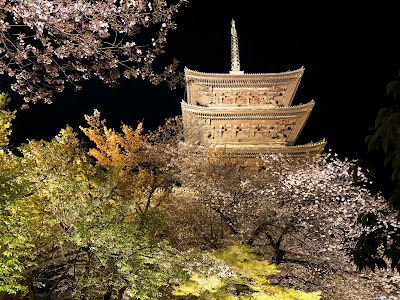-- Susan, every other Sunday
It is a well-known fact, universally acknowledged, that Japan goes sakura (flowering cherry blossom) crazy in the spring.
 |
| Sakura in Meguro, March 2021 |
Our hanami (flower viewing) was mostly hana-missing this year, thanks to The Virus That Shall Not Be Named, though I was fortunate enough to enjoy the blossoms in my neighborhood (which has several large and small streets lined with ornamental cherry trees).
 |
| More neighborhood sakura |
In addition to picnics under the blossoms, one of the most popular ways to see the sakura (in a normal year) is during the nighttime "illuminations" put on by parks and temples--including a number of locations that ordinarily aren't open after the sun goes down.
Two years ago last week, I was in Kyoto (with fellow author Laura VanArendonk Baugh) preparing for the final hikes of my 100-summits year. While spending a rest day afternoon in the ancient capital, we noticed a poster advertising an evening illumination at Tō-ji, a Buddhist temple founded in 796 that also bears the distinction of having been one of only three Buddhist temples in Kyoto at the time the city became the capital of Japan.
The temple was declared a UNESCO World Heritage site in 1994 (as part of the "Historic Monuments of Ancient Kyoto" group), and five of the temple buildings are also designated Japanese National Treasures.
According to the poster, this was the final day of the illumination, and since neither Laura nor I had ever seen the sakura by night, we made it a point to go.
 |
| Sakura Illumination at Tō-ji |
We were not disappointed.
The sakura line the banks of the temple's central lake, and surround the five-storied pavilion at the far end of the grounds.
In 823, the temple was rededicated as a Shingon (esoteric Buddhist) temple, and has remained an active center of Shingon worship since that time. Like many of Japan's famous shrines and temples, it is now both a historical/cultural site of interest and a place of worship.
To-ji's five-story pagoda is the tallest in Japan. The current pagoda is the fifth incarnation (the previous four all burned to the ground, either through human actions or as a result of lightning strikes); it stands 55 meters high and dates to 1644. An interesting architectural fact about the pagoda: it rests on a concrete foundation, with no supporting pillars anchored in the ground. Even so, it has never fallen in an earthquake, because the design allows each wooden layer to shift independently from the others, letting it "shimmy" and remain standing during earthquakes. Pretty cool, considering this is a pre-tenth century design.
 |
| Sakura by night |
Seen by night, the sakura blossoms almost seem to glow; they also show up beautifully against the darkness of the sky.
They look particularly striking next to the ancient architecture, too.
The Kodo (lecture hall) in the photo above stands at the center of the temple grounds, and contains a 3-D mandala composed of 21 statues, representing various incarnations of the Buddha, Bodhisattvas (enlightened beings), Wisdom Kings, and Guardians. The arrangement of the statues in mandala form is an important element of Shingon teaching and practice; most mandalas are presented in two-dimensional form, as scrolls or paintings. However, several 3-dimensional mandalas exist at important Shingon temples in Japan, including the one at Tō-ji and another in the three-story pagoda on Kōyasan. (Due to the sacred nature of the mandalas and the halls in which they stand, photography is not allowed--so if you want to see them, you can check
the official website of Tō-ji or come to Japan and see it for yourself!)
Of course, the moon put in an appearance too.
 |
| The famous weeping cherry |
The weeping cherry tree at Tō-ji is over 130 years old and stands over 13 meters (36 feet) tall. The ancient tree is surrounded by a group of wooden supports designed to protect the heavy branches. It's a focal point of the temple garden throughout the year, but particularly spectacular in the spring.
The sakura have already come and gone in most of Japan this year--perhaps with less fanfare than normal (and definitely with fewer crowds and no illuminations), but no less beloved for the loss of the picnics and evening strolls.
In some ways, it was reassuring to see the flowers come (and go) this spring--they were an important reminder that although our lives have been disrupted in many ways, the seasons come and go on schedule. Next spring, the sakura will come again--I hope, on a world that's healthy and happy enough to celebrate the beauty of blossoms in the night once more.
Wishing you and yours health and safety as spring becomes summer.


























Gorgeous! Thanks for sharing, and those same good wishes to you also, Susan.
ReplyDeleteThose illuminated sakura are spectacular.
ReplyDeleteBarbara and I wish you the same good health and safety, Susan, as you pass these days in your land of enchantment, kindly sharing so much of it with all of us.
ReplyDelete